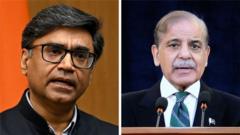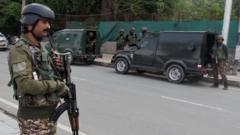Following a brief but intense conflict, a cease-fire between India and Pakistan has led to signs of normalization, though challenges remain for the displaced and diplomatic relations still hang in the balance.**
Renewed Hope as India-Pakistan Cease-Fire Holds Amidst Tensions**

Renewed Hope as India-Pakistan Cease-Fire Holds Amidst Tensions**
Civilian life is returning to normal in both countries following a cease-fire agreement, showcasing optimism even as conflict remains a concern.**
In the aftermath of a significant cease-fire agreement, India and Pakistan have begun to show signs of returning to normalcy. On Monday, both nations experienced a surge in stock markets and a resumption of civilian flights, following a weekend truce that halted extensive hostilities that had marked their relationship in recent weeks.
Markets opened to significant gains, particularly in Pakistan, where the Karachi 100 index soared nearly 9 percent, prompting a temporary halt in trading due to rapid increases. India’s stock market also rebounded, erasing previous losses amid cautious optimism that the cease-fire could hold.
The cease-fire comes after a week of intense fighting initiated by a tragic terrorist attack in Kashmir, which both nations claim as their territory. In the wake of the attack, India launched airstrikes targeting what it labeled as terrorist facilities in Pakistan, escalating retaliation efforts. This conflict resulted in numerous casualties and displaced tens of thousands of civilians along the shared border.
Despite the welcome return of flights and market stability, the situation remains fragile. Leaders from both sides were reportedly scheduled to meet on Monday to discuss the future of the cease-fire, but as of the latest updates, no new developments had been announced.
This truce, facilitated by mediation from the United States, reflects a continuing pattern of international involvement in stabilizing the long-standing conflict. While there are hopes for lasting peace, the complexities and historical grievances between both nations suggest that the road ahead may still be fraught with challenges.
Markets opened to significant gains, particularly in Pakistan, where the Karachi 100 index soared nearly 9 percent, prompting a temporary halt in trading due to rapid increases. India’s stock market also rebounded, erasing previous losses amid cautious optimism that the cease-fire could hold.
The cease-fire comes after a week of intense fighting initiated by a tragic terrorist attack in Kashmir, which both nations claim as their territory. In the wake of the attack, India launched airstrikes targeting what it labeled as terrorist facilities in Pakistan, escalating retaliation efforts. This conflict resulted in numerous casualties and displaced tens of thousands of civilians along the shared border.
Despite the welcome return of flights and market stability, the situation remains fragile. Leaders from both sides were reportedly scheduled to meet on Monday to discuss the future of the cease-fire, but as of the latest updates, no new developments had been announced.
This truce, facilitated by mediation from the United States, reflects a continuing pattern of international involvement in stabilizing the long-standing conflict. While there are hopes for lasting peace, the complexities and historical grievances between both nations suggest that the road ahead may still be fraught with challenges.






















